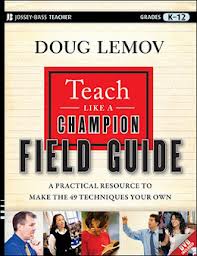Techniques to Refresh Teaching
Teach Like a Champion Field Guide: A Practical Resource to Make the 49 Techniques Your Own
by Doug Lemov
(Jossey-Bass, 2012 – Learn more)
Who in the teaching profession doesn’t continually strive to improve teaching technique, classroom control, organization, student attention, increased learning, retention, and test scores? In this massive workbook, Doug Lemov has compiled a companion guide to the 49 techniques presented in his 2010 Teach Like a Champion. The goal: to help teachers, whether new or experienced, strengthen those areas already strong in your classroom, improve weaker areas, and “make the 49 techniques your own.”
The book is extensive, 457 pages in all, which may be intimidating at first glance. But the organization of the contents is logical and sequential, so the material is quite accessible.
Friendly and clear organization

Divided into seven areas of emphasis, techniques fall into one of the following groups – academic expectations, planning for high academic achievement, structuring and delivering lessons, engaging students, classroom culture, setting and maintaining high behavioral expectations, building character and trust. This allows the user to find and focus on techniques unique to those sections.
The introduction
The introduction provides valuable recommendations for where and how to start with the guide, how to benefit from the video clips included on the enclosed DVD, recommendations for recording your classroom teaching, working with a group and/or partner, and the value of brainstorming during the process.
A brief background on the Uncommon Schools charter organization — the originator of many of the ideas and activities found in this book — supports the value and success of using the techniques in the classroom. A map that follows the intro conveys for users a valuable visual of how each technique interacts with the others, thus imparting a picture of the whole learning framework.
The chapters
At the beginning of each chapter, a brief overview explains the technique presented and identifies its role and value. The rubric that follows helps the user to determine where his/her levels of proficiency, confidence and comfort fall in using the technique in the classroom. This serves as a great starting point in self-analysis.
Video clips (included on the DVD) corresponding to the technique are listed, and a sidebar includes notes about other techniques that can be observed in the same clip. Each technique also includes questions for discussion and self-reflection, suggestions for practicing (with a group or study partner), occasional role-plays, and then advice on trying the technique in the classroom — all of which should lead to mastery.
Each chapter concludes with a final section designed to analyze and evaluate the classroom experience and help with troubleshooting any problems. Additional text boxes with supplementary challenges and solutions, as well as a chart to record individual progress, conclude every chapter.
The DVD
The accompanying DVD includes helpful video examples from Uncommon Schools classrooms, with teachers actively implementing one or more of the 49 Techniques. Most clips are just long enough to show the technique in action; display student attentiveness, cooperation, etc., and indicate how valuable utilization of the technique(s) is to the classroom. These videos are very interesting, easy to access, and a great accompaniment to the written material in the book.
The techniques
We all strive to improve our teaching, and I think that utilizing even a few of the 49 techniques can bring about improvement in student responsiveness and classroom participation. Many are easily adaptable for all grade levels and classroom subjects. We probably do lots of them without even realizing it; watching others do them may help us improve our own technique.
As recommended in the introduction, choosing to begin with Cold Call along with No Opt Out (techniques 1 and 22) will encourage students in your classroom to be actively involved, attentive, and on task. Other useful techniques help set the tone in the classroom.
Because the book is formatted as a guide or workbook, with a massive amount of information, it’s obviously not designed to be consumed in only a few readings. Instead, teachers can read, think, process, discuss, implement, and hone techniques over time. With that in mind, I think that attempting to master all 49 techniques during ongoing instruction would be difficult to manage, exhausting, and likely to take away the teacher’s focus on subject content and other teaching strategies. Balance is necessary — these techniques can certainly make a worthy contribution to teaching practice, but they are only a part of the whole classroom experience.
An excellent resource!
I love books, and especially books on teaching, working with students, and developing classroom materials. Any time I come across a resource that provides new and useful information to refresh my classroom teaching, it’s very satisfying. This field guide was just such a book.
Even though it’s unlikely that I will master every single technique, I found many useful ones to apply in my classroom this fall, from Tight Transitions-#30, Entry Routine-#28, Binder Control-#31, to of course, Vegas-#27, which creates fun in learning, and the Joy Factor-#46 where students celebrate the joy of gaining knowledge and skills. I’m glad the new school year has begun!
Susan Shaver is the K-12 Library Media Specialist with Hemingford Public Schools in Hemingford, Nebraska, where she also teaches a 7th grade reading class and junior high general music. A graduate of the University of Nebraska at Lincoln, she holds a Bachelor’s in Music Education degree, endorsements in Library Media and English, and a Master of Science in Educational Technology degree from Chadron State College.


































